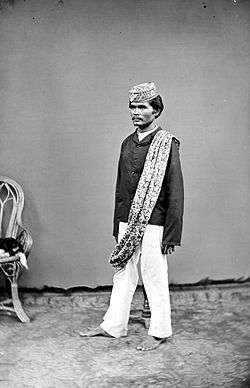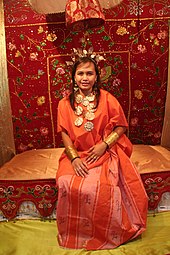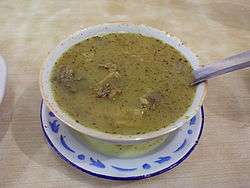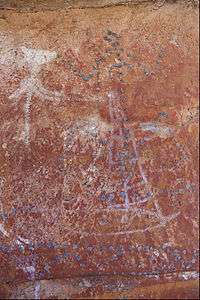Makassarese people
The Makassarese or Makassar people are an ethnic group that inhabits the southern part of the South Peninsula, Sulawesi (formerly Celebes) in Indonesia. They live around Makassar, the capital city of the province of South Sulawesi, as well as the Konjo highlands, the coastal areas, and the Selayar and Spermonde islands. They speak Makassarese, which is closely related to Buginese and also a Malay creole called Makassar Malay.
 A Makassar man, 1913. | |
| Total population | |
|---|---|
| 2,672,590 (2010 census)[1] | |
| Regions with significant populations | |
| 2,672,590[2] | |
| | 2,380,208 |
| | 59,301 |
| | 41,239 |
| | 31,701 |
| | 29,444 |
| | 25,367 |
| Languages | |
| Makassarese, Makassar Malay, Indonesian | |
| Religion | |
| Predominately Islam, very few adherents of Animism and Christianity | |
| Related ethnic groups | |
| Bugis, Mandar, Toraja | |
Lifestyle
The main source of income of the Makassar is rice farming; however, they are also famous throughout Indonesia for their skill in trading and as fishermen.
Labor division is strict because of the rigid separation of the sexes, as in all traditional Muslim communities. Men are engaged in matters outside the house such as farming, fishing, etc. Women are usually responsible for the household duties, while the man is the head of the family. While they are in public, respect should be shown to him by the wife and children. Usually the final decisions concerning the family are made by the husband. In rural areas, arranged marriage is still widely practiced.
Polygamy is accepted by the Makassar people, but, since a separate house must be provided for each wife, it is only practiced among the wealthy people.
Siri (respect and honor) is the social code by which the Makassar live. Anyone seriously offending another person's siri carries the risk of being killed, in which case authorities often refuse to intervene. The Makassar often help their neighbors in matters such as working in the rice fields and building houses.
Language
Makassarese language
The Makassarese language, also referred to as Basa Mangkasara (ISO code: mak), is the language spoken by the Makassar people. This language is classified as part of Makassaric branch of the South Sulawesi subgroup which in turn is part of the Malayo-Polynesian branch of the Austronesian language family.
Makassar Malay language
Commonly known as "Logat Makassar" (Makassar Dialect; ISO code: mfp) is a creole of Malay. This language is used as the language of commerce in the port of Makassar, South Sulawesi. The number of speakers is reached 1.889 million inhabitants in 2000 and an estimated number of speakers of these languages continue to grow until it reaches ± 3.5 million inhabitants. The language is mostly used by Immigrants from outside the city of Makassar, Makassar City Population, Youth Makassar, or people who are not proficient in Makassarese. This language is spoken along the South Peninsula region of Sulawesi.
Religion

The Makassar are almost all Muslim, but some traditional pre-Islamic beliefs are still influential, especially in the remote areas.
History
Islam began officially accepted into the structure of Indianized Gowa Kingdom since 1605, marked by the arrival of three scholars from Koto Tangah, Minangkabau. One of the three scholars Minangkabau is Single Khatib Abdul Makmur who holds Dato'ri Bandang. Ahmad Hidayat in his article titled "Islamic History Up to the archipelago" said Dato'ri Bandang are scholars who propagated Islam in the territory of the Kingdom of Gowa.

While two other colleagues, each spread Islam in the region and in the Kingdom of Luwu Bulukumba. Da'wah conducted by Dato'ri Bandang not only touch the lower layers of society, but also merchants and nobles Gowa. In fact, during Dato'ri Bandang spread the teachings of Islam there, one of the rulers of the Kingdom of Gowa, the King of Gowa-14, I Manga'rangi Daeng Manrabia the title of Sultan Alauddin Tumenanga ri Gaukanna embraced Islam. Previously, Mangkubumi Gowa, who also serves as the King Tallo, I Malingkaang Daeng Nyonri or Karaeng Katangka, first embraced Islam. He then got the name of Islam Sultan Abdullah al-Islam Awwal. Since then, the Kingdom of Gowa who are in the southern part of South Sulawesi became the center of the spread of Islam since Islam serve as the official religion of the Kingdom of Gowa.
Culture

Philosophy
Culture Siri 'Na Pacce is one cultural philosophy Bugis-Makassar Society which must be upheld. If siri 'na pacce not a person, then that person may exceed the behavior of animals, because it has no sense of shame, self-esteem, and social concerns. They also just want to win yourself and indulge his desires. The term siri 'na pacce as a cultural value system is very abstract and difficult to be defined as the series' na pacce only be felt by the adherents of that culture. For the people of Bugis-Makassar, siri 'teach morality in the form of advice decency, prohibition, the rights and obligations that dominate human action to preserve and defend himself and his honor. Siri 'is a shame that decomposes in the dimensions of human dignity, siri' is something that is 'taboo' for the people of Bugis-Makassar in interacting with others. Meanwhile, pacce teach solidarity and social care unselfishly and inil group is one of the concepts that make the Bugis-Makassar able to survive and respected diperantauan, pacce a compassionate nature and feeling the burden and suffering of others.
From the aspect of ontology (a form of) culture siri 'na pacce have a very strong relationship with the view of Islam in terms of spirituality, where the strength of the soul can teraktualkan through conquest soul over the body. The core culture of siri 'na pacce cover all aspects of community life Bugis-Makassar, because siri' na pacce the identity of the Bugis-Makassar. With the philosophy and ideology siri 'na pacce the attachment between people and solidarity become stronger, both with fellow tribe or with other tribes. The concept of the series' na pacce not only embraced by these two tribes (Bugis and Makassar), but also embraced by other tribes who inhabit such Sulawesi mainland, Mandar tribe and Tator, only vocabulary and their mention are different, but the philosophy ideological similarity memilikii in interacting with others.
By type, Siri' divided 2, namely :
- Siri 'Nipakasiri' occurs when someone insulted or treated outside the boundaries of reasonableness. Then he or his family had to enforce siri'nya to restore the honor that has been deprived of, if not it will be called "mate siri" or dead status and dignity as human beings. For the Bugis and Makassar, there is no purpose or reason for the higher life of the guard siri'nya, they would rather die than live without siri '. Death for maintaining siri 'called "mate nigollai..mate nisantangngi" which means to die with dignity to maintain self-esteem.
- Siri 'Masiri' is a way of life that intends to maintain, improve or achieve a feat performed by earnest and hard with exhaust all means for the sake of the series' itself. Like a piece of poetry sinrili '"Takunjunga' bangung turu '.. Nakugunciri' gulingku .. Kuallengi Tallanga Natoalia" which means "My Sails has been I opened .. have I put my steering .. I chose sinking of the step back". The slogan symbolizes how society Bugis-Makassar has a high determination and courage in this life.
Based on the values of the culture contained siri 'na pacce divided into three, namely:
- Philosophical value. Philosophical value siri 'na pacce is a picture of the way of life of people Bugis and Makassar on various issues of life that includes the character of the Bugis Makassar reactive, militant, optimistic, consistent, loyal, courageous and constructive.
- Ethical values. On ethical values siri 'na pacce are values which include: firm establishment, loyal, know yourself, honest, wise, humble, polite, love and empathy.
- Aesthetic value Aesthetic value of the series' na pacce include aesthetic values in non-human nature consisting of inanimate objects, natural objects vegetable, animal and natural objects.
Culture siri 'na pacce is something that is needed by this nation, to become a great nation. It is necessary for younger figures who has a soul and character are established for youth leaders and owners of this nation. They should have a series of 'na pacce in themselves, with their culture siri' na pacce young children of this nation will be more sensitive to all kinds of problems that are sweeping the nation.
A leader who has a culture siri 'na pacce in itself will be a leader who has the courage and firmness, but remain prudent in the lead. A leader who hold this principle will lead the country towards a better direction, because they have a sense of environmentally sensitive, able to listen to the aspirations of the people they lead.
Traditional attire
Baju bodo (lit. 'short blouse' in Makassarese) is a traditional upper garment of Makassarese women. The baju bodo has a rectangular shape, and is usually short-sleeved, i.e. half above the elbow. According to Makassarese custom, the color of the baju bodo indicates the age or the dignity of the wearer. It is often used for ceremonies such as wedding ceremonies. But now, baju bodo is revitalized through other events such as dance competitions or guest welcome receptions.
Cuisine

Makassarese cuisine uses a blend of agrarian and maritime ingredients. On the west coast such as Makassar, Maros, Pangkep, there are coastal areas directly adjacent to the area of rice fields. Agricultural areas are quite extensive in the Maros region and Pangkep. Rice and other crops such as bananas are abundant, almost all dishes–such as traditional cakes–are predominantly made from rice and banana.
Coastal areas of South Sulawesi are also becoming an important producer of fish, ponds scattered on the west coast with the results of bolu (milkfish), shrimps, sunu (grouper) and crabs. The tradition of fishing in coastal and high seas, is well-developed, among others tuna is caught.
The "agrarian pattern" is found in Makassarese dishes which are made from beef or buffalo; prime example are: coto, konro, sop saudara, and pallubasa.
Because it is near the coast, abundant catches of fish mean that people predominantly eat fish. Unlike in other regions (e.g. Jawa), where fish is a side dish to rice, in South Sulawesi fish is the main dish, with rice as a side dish.
Differences between the Buginese and Makassarese people
There is a common perception that the Makassarese people are identical and ethnically cognate to the Buginese people, and that the term Buginese and Makassarese are terms that are coined by the Dutch colonials to create a division among them. All potentials were lost once the Sultanate of Makassar fell to the Dutch colonial, since these people were notoriously rebellious against the Dutch colonials.[3] Wherever these people encounter the Dutch colonials, conflicts are bound to happen. Several notable figures centered in Gowa Regency that refused to surrender like Karaeng Galesong, migrated to Central Java. Along with his powerful naval fleet, they would engage in war against any Dutch vassals that they would encounter. Hence, the Dutch colonials at that time under Cornelis Speelman calls him the Si-Bajak-Laut, meaning "the pirate".[4]
In linguistic terms, Makassarese and Buginese are distinct languages, even though both of these languages belong to the South Sulawesi group[5] within the Malayo-Polynesian languages branch of the Austronesian languages. In this category, the Makassarese language is under same the sub-category as Bentong, Coastal and Highland Konjo and Selayar;[6] while Buginese is under the same sub-category as Campalagian language and along with another 2 languages spoken in Kalimantan, Embaloh and Taman.[7] This differences between the Bugis and Makassar people are one of the characteristics that differentiate the two people group.
The idea that the Buginese and Makassar people are ethnically cognate derives from the conquest of kingdoms such as Bone state and Wajo Kingdom by the Sultanate of Gowa.
Contact with Australia
Makassar trepangers from the southwest corner of Sulawesi (formerly Celebes) visited the coast of northern Australia in the eighteenth and nineteenth centuries to collect and process trepang (also known as sea cucumber), a marine invertebrate prized for its culinary and medicinal values in Chinese markets. The term Makassan (or Macassan) is generally used to apply to all the trepangers who came to Australia, although some were from other islands in the Indonesian Archipelago, including Timor, Rote and Aru.

Fishing fleets began to visit the northern coasts of Australia from Makassar in southern Sulawesi, Indonesia from about 1720, but possibly earlier. While Campbell Macknight's classic study of the Makassan trepang industry accepts the start of the industry as about 1720, with the earliest recorded trepang voyage made in 1751,[8] Regina Ganter of Griffith University notes a Sulawesi historian who suggests a commencement date for the industry of about 1640.[9] Ganter also notes that for some anthropologists, the extensive impact of the trepang industry on the Yolngu people suggests a longer period of contact. Arnhem land rock art, recorded by archaeologists in 2008, appears to provide further evidence of Makassan contact in the mid-1600s.[10] Contact has even been proposed from as early as the 1500s.[11]
At the height of the trepang industry, Makassans ranged thousands of kilometres along Australia's northern coasts, arriving with the north-west monsoon each December. Makassan perahu or praus could carry a crew of thirty members, and Macknight estimated the total number of trepangers arriving each year as about one thousand.[12] The Makassan crews established themselves at various semi-permanent locations on the coast, to boil and dry the trepang before the return voyage home, four months later, to sell their cargo to Chinese merchants.[13] Marege' was the Makassan name for Arnhem land, (meaning literally "Wild Country") from the Cobourg Peninsula to Groote Eylandt in the Gulf of Carpentaria. Kayu Jawa was the name for the fishing grounds in the Kimberley region of Western Australia, from Napier Broome Bay to Cape Leveque. Other important fishing areas included West Papua, Sumbawa, Timor and Selayar. Matthew Flinders in his circumnavigation of Australia in 1803, met a Makassan trepang fleet near present day Nhulunbuy. He communicated at length with a Makassan captain, Pobasso, through his cook, who was also a Malay, and learned of the extent of the trade from this encounter. Ganter adds: "1,000 Macassans...must have seen a veritable invasion against the fewer than 7,000 British nestled into Sydney Cove and Newcastle." [14] Nicholas Baudin also encountered 26 large perahu off the northern coast of Western Australia in the same year.[15] Ganter states that the British settlements of Fort Dundas and Fort Wellington were established as a result of Phillip Parker King's contact with Makassan trepangers in 1821.[14]
Using Daeng Rangka, the last Makassan trepanger to visit Australia, lived well into the 20th century and the history of his voyages are therefore well documented. He first made the voyage to northern Australia as a young man. He suffered dismasting and several shipwrecks, generally positive but occasionally conflicting relationships with Indigenous Australians, and was the first trepanger to pay the South Australian government trepanging licence in 1883, an impost that made the trade less viable.[16] The trade continued to dwindle toward the end of the 19th century, due to the imposition of customs duties and licence fees and probably compounded by over fishing. Using Daeng Rangka commanded the last Makassar perahu, which left Arnhem Land in 1907.
References
- Na'im, Akhsan; Syaputra, Hendry (2010). "Nationality, Ethnicity, Religion, and Languages of Indonesians" (PDF) (in Indonesian). Statistics Indonesia (BPS). Archived (PDF) from the original on 23 September 2015. Retrieved 23 September 2015.
- Kewarganegaraan, Suku Bangsa, Agama dan Bahasa Sehari-hari Penduduk Indonesia Hasil Sensus Penduduk 2010. Badan Pusat Statistik. 2011. ISBN 9789790644175. Archived from the original on 2017-07-10.
- Carl Fredrik Feddersen (2017). "Principled Pragmatism: VOC Interaction with Makassar 1637-68, and the Nature of Company Diplomacy". Cappelen Damm Akademisk. ISBN 978-82-02-56660-9. Retrieved 2018-06-23.
- Adnan M. (2014). "Pertimbangan Hakim dalam menjatuhkan putusan perkara Pidana terhadap pelaku kekerasan massal (Tawuran) antara Mahasiswa Dikota Makasar" (PDF). Universitas Muhammadiyah Yogyakarta. Retrieved 2018-06-23.
- "South Sulawesi". Ethnologue. Retrieved 2018-06-23.
- "Makasar". Ethnologue. Retrieved 2018-06-23.
- "Bugis". Ethnologue. Retrieved 2018-06-23.
- MacKnight,C.C. (1976).The Voyage to Marege': Macassan Trepangers in Northern Australia. Melbourne University Press. ISBN 0-522-84088-4
- Ganter,R.(2008) Journal of Australian Studies, Volume 32,4, 2008: "Muslim Australians: the deep histories of contact.""Archived copy" (PDF). Archived from the original (PDF) on 2012-04-15. Retrieved 2013-01-14.CS1 maint: archived copy as title (link) Retrieved on 6 April 2012
- Hidalgo Tan, N.(2010) SEAArch. South East Asian Archaeology blog: Retrieved on 6 April 2012
- Janak Rogers (24 June 2014). "When Islam came to Australia". BBC News Magazine. Retrieved 25 June 2014.
- Macknight, C.C. (1976), p.29
- Stephenson, P.(2010)Islam Dreaming: Indigenous Muslims in Australia. P.22-6. University of New South Wales Press,Sydney. ISBN 978-1-74223-247-8
- Ganter, R. (2005) "Turn the Map upside down" in Griffith Review Edition 9, 2005. "Up North: Myths, Threats and Enchantment." Griffith University.
- Russell, D. Australian Aboriginal Studies 2004, Number 1. "Aboriginal-Makassan interactions in the eighteenth and nineteenth centuries in northern Australia and contemporary sea rights claims." P.6-7. Australian Institute of Aboriginal and Torres Strait Islander Studies. Retrieved on 6 April 2012
- Macknight, C. C., 'Using Daeng Rangka (1845–1927)', Australian Dictionary of Biography, National Centre of Biography, Australian National University, Retrieved on 6 April 2012